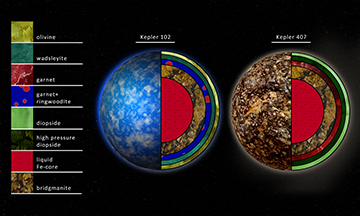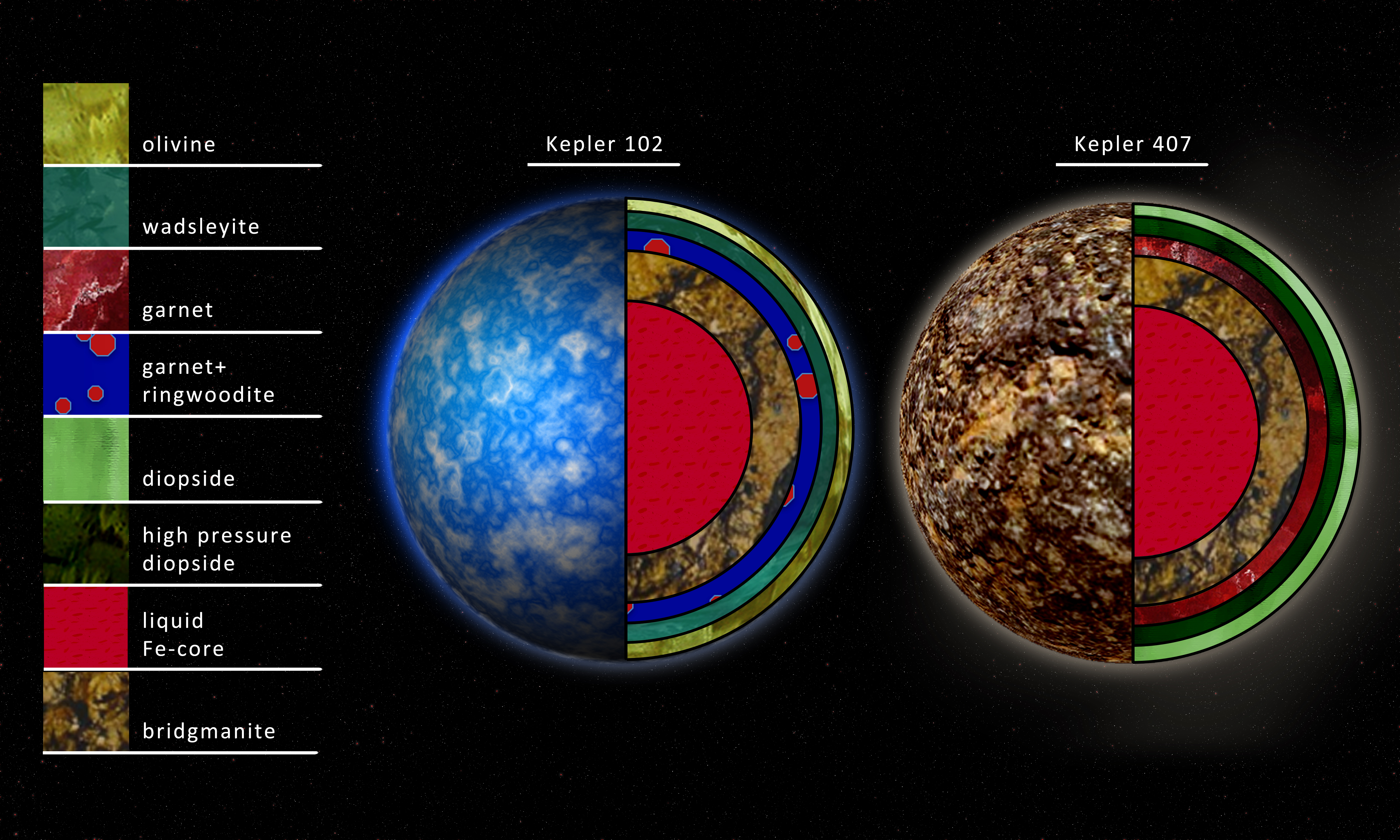Artist rendition of interior compositions of planets around the stars Kepler 102 and Kepler 407.
The picture shows what minerals are likely to occur several different depths. Kepler 102 is Earth-like, dominated by olivine minerals, whereas Kepler 407 is dominated by garnet, so less likely to have plate tectonics.
Click on the image for a larger version.
Image Credit: Robin Dienel, Carnegie DTM
What makes a rocky planet Earth-like?
Astronomers and geoscientists have joined forces using data from the Sloan Digital Sky Survey (SDSS) to study the mix of elements in exoplanet host stars, and to consider what this reveals about their planets.
In results presented today at the American Astronomical Society (AAS) meeting in Grapevine, Texas, astronomer Johanna Teske explained, “our study combines new observations of stars with new models of planetary interiors. We want to better understand the diversity of small, rocky exoplanet composition and structure — how likely are they to have plate tectonics or magnetic fields?”
Earth-sized planets have been found around many stars — but Earth-sized does not necessarily mean Earth-like. Some of these Earth-sized planets have been found orbiting stars with chemical compositions quite different from our Sun, and those differences in chemistry could have important consequences.
Johanna Teske
“We want to better understand the diversity of small, rocky exoplanet composition and structure — how likely are they to have plate tectonics or magnetic fields?”
Astronomers in the Sloan Digital Sky Survey have made these observations using the APOGEE (Apache Point Observatory Galactic Evolution Experiment) spectrograph on the 2.5m Sloan Foundation Telescope at Apache Point Observatory in New Mexico. This instrument collects light in the near-infrared part of the electromagnetic spectrum and disperses it, like a prism, to reveal signatures of different elements in the atmospheres of stars. A fraction of the almost 200,000 stars surveyed by APOGEE overlap with the sample of stars targeted by the NASA Kepler mission, which was designed to find potentially Earth-like planets. The work presented today focuses on ninety Kepler stars that show evidence of hosting rocky planets, and which have also been surveyed by APOGEE.
In particular, Teske and colleagues presented solar systems around the stars Kepler 102 and Kepler 407. Kepler 102 is slightly less luminous than the Sun and has five known planets; Kepler 407 is a star almost identical in mass to the Sun and hosts at least two planets, one with a mass less than 3 Earth masses.
“Looking at these two exoplanet systems in particular,” Teske explains, “we determined that Kepler 102 is like the Sun, but Kepler 407 has a lot more silicon.”
To understand what a lot more silicon might mean for the planets around Kepler 407, astronomers turned to geophysicists for help. Cayman Unterborn of Arizona State University ran computer models of planet formation. “We took the star compositions found by APOGEE and modeled how the elements condensed into planets in our models. We found that the planet around Kepler 407, which we called ‘Janet,” would likely be rich in the mineral garnet. The planet around Kepler 102, which we called ‘Olive,’ is probably rich in olivine, like Earth.”
That seemingly-small difference in minerals might have major consequences for Janet and Olive. Garnet is a stiffer mineral than olivine, so it flows more slowly. Unterborn explains that this means that a garnet planet like Janet would be much less likely to have long-term plate tectonics. “To sustain plate tectonics over geologic timescales, a planet must have the right mineral composition,” Unterborn says.
Wendy Panero
“Without these geological processes, life may not have had the chance to evolve on Earth.”
Plate tectonics is believed to be essential for life on Earth, because of how volcanoes and ocean ridges recycle elements between Earth’s crust and mantle. This recycling regulates the composition of our atmosphere. Wendy Panero of the School of Earth Sciences at The Ohio State University says that “without these geological processes, life may not have had the chance to evolve on Earth.” Determining the likelihood of such geological processes on other planets will help distinguish which ones are the best targets for future missions searching for signs of life. “If we’re looking for a needle,” Panero says, “why not start in the sewing box?”
The next step in the team’s research is to extend this study to all of the stars observed by APOGEE that host small planets. That extension would allow astronomers to map out a wider range of planet compositions and structures to find those most likely to be Earth-like in their mineral content. Teske concludes, “As we’ve learned more about the Earth, we have learned about how many pieces come together to make it habitable. How often will exoplanets get that lucky?”
Images
Artist rendition of interior compositions of planets around the stars Kepler 102 and Kepler 407.
The picture shows what minerals are likely to occur several different depths. Kepler 102 is Earth-like, dominated by olivine minerals, whereas Kepler 407 is dominated by garnet, so less likely to have plate tectonics.
Click on the image for a larger version.
Image Credit: Robin Dienel, Carnegie DTM
Contacts
- Johana Teske, The Carnegie Observatories, jteske@carnegiescience.edu, 202-478-4885,
Twitter: @johannateske / @APOGEEsurvey - Cayman Unterborn, Arizona State University, cayman.unterborn@asu.edu, 937-239-4152,
Twitter: @ItsATrappist - Wendy Panero, The Ohio State University, panero.1@osu.edu, 614-292-6290,
Twitter: @MineralToPlanet - Karen Masters, SDSS Scientific Spokesperson, University of Portsmouth (UK),
karen.masters@port.ac.uk, +44 (0)7590 526600,
Twitter: @KarenLMasters / @SDSSurveys - Jordan Raddick, SDSS Public Information Officer, Johns Hopkins University, raddick@jhu.edu, 1-443-570-7105,
Twitter: @raddick
About the Sloan Digital Sky Survey
Funding for the Sloan Digital Sky Survey IV has been provided by the Alfred P. Sloan Foundation, the U.S. Department of Energy Office of Science, and the Participating Institutions. SDSS acknowledges support and resources from the Center for High-Performance Computing at the University of Utah. The SDSS web site is www.sdss.org.
SDSS is managed by the Astrophysical Research Consortium for the Participating Institutions of the SDSS Collaboration including the Brazilian Participation Group, the Carnegie Institution for Science, Carnegie Mellon University, the Chilean Participation Group, the French Participation Group, Harvard-Smithsonian Center for Astrophysics, Instituto de Astrofísica de Canarias, The Johns Hopkins University, Kavli Institute for the Physics and Mathematics of the Universe (IPMU) / University of Tokyo, Lawrence Berkeley National Laboratory, Leibniz Institut für Astrophysik Potsdam (AIP), Max-Planck-Institut für Astronomie (MPIA Heidelberg), Max-Planck-Institut für Astrophysik (MPA Garching), Max-Planck-Institut für Extraterrestrische Physik (MPE), National Astronomical Observatories of China, New Mexico State University, New York University, University of Notre Dame, Observatório Nacional / MCTI, The Ohio State University, Pennsylvania State University, Shanghai Astronomical Observatory, United Kingdom Participation Group, Universidad Nacional Autónoma de México, University of Arizona, University of Colorado Boulder, University of Oxford, University of Portsmouth, University of Utah, University of Virginia, University of Washington, University of Wisconsin, Vanderbilt University, and Yale University.





